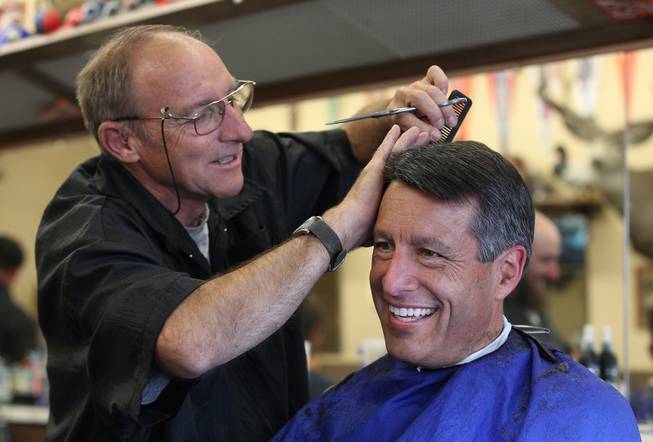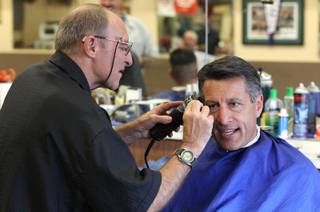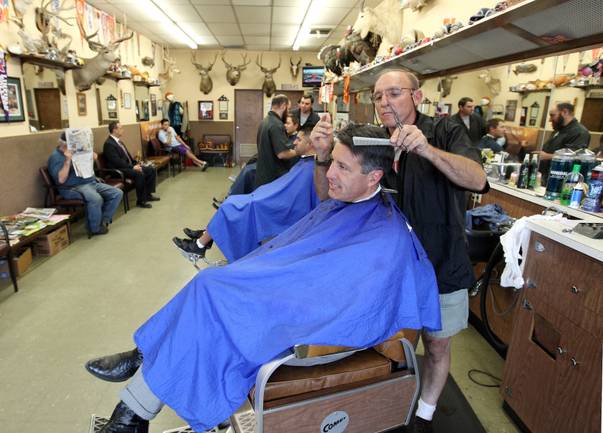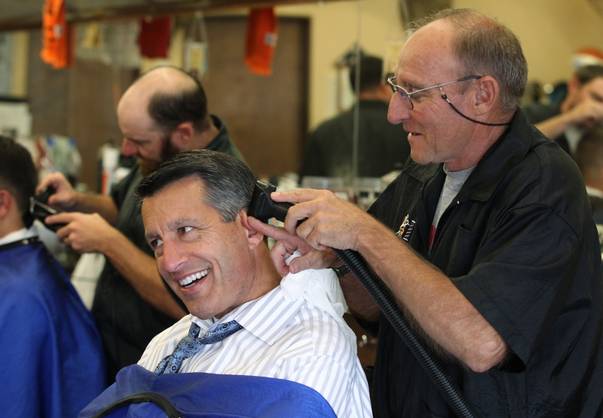
Cathleen Allison / AP
Barber Don Diehl cuts Gov. Brian Sandoval’s hair Thursday, Oct. 14, 2014, in Sparks. Diehl says they don’t talk politics — it’s all about family and sports.
Monday, Nov. 3, 2014 | 2 a.m.
The Paradise Park Barber Shop sits in a strip mall still gripped by the recession. It’s a suburban relic anchored by a Kmart, Family Dollar and coin laundry. Twelve storefronts in the plaza are empty. The barbershop is not the kind of place where you’d expect to find the CEO of a state paying for a trim. But every few weeks, a navy blue SUV pulls into the parking lot, and Gov. Brian Sandoval steps out.
At public appearances and in campaign ads, Sandoval looks like a man whose haircuts are fashioned by stylists. But the governor waits his turn for a $14 trim surrounded by trophy buck mounts and bobblehead dolls in a strip mall 30 miles from the Capitol.
When Sandoval walked in Oct. 16, he was met with handshakes and fawning. A customer who had been alerted the governor was coming handed Sandoval a grocery bag full of venison steaks. A picture of Sandoval and a local Boy Scout troop hangs on the wall. A collegiate pennant from Sandoval’s son’s college also has a coveted spot. No one talks politics. Why would they?
Sandoval’s re-election campaign came without the negative ads, debates and vitriol seen in other statewide races. Despite being vulnerable on a number of fronts — education and health care among them — Sandoval didn’t draw a single serious challenger. Even U.S. Sen. Harry Reid, the architect of the state’s Democratic machine, couldn’t persuade anyone to step forward.
LIFE OF BRIAN: A timeline of Sandoval, from birth to mansion
°1963: Sandoval is born Aug. 5, the son of Ron and Gloria, in Redding, Calif.
° 1970: The Sandoval family moves to Fallon before moving to Sparks two years later.
°1981: Sandoval graduates from Bishop Manogue High School, where he was a star athlete.
°1984: Sandoval lands an internship with Republican Sen. Paul Laxalt, who rose to national prominence because of his close relationship with President Ronald Reagan.
°1986: Sandoval graduates from UNR with degrees in English and economics.
°1989: Sandoval graduates from Ohio State University’s Moritz College of Law.
°1989 to 1994: Sandoval works as a lawyer at a private practice in Reno.
°1994 to 1998: Sandoval runs for and wins two terms in the state Assembly.
°1999 Gov. Kenny Guinn selects Sandoval as youngest chairman in the history of the Nevada Gaming Commission.
°2001: Sandoval resigns from the Gaming Commission to run for attorney general.
°2002: Sandoval is elected as Nevada’s first Latino attorney general
°2005 Sandoval resigns as attorney general. The U.S Senate confirms him as a federal judge.
°2009 Sandoval resigns as a federal judge to run for governor.
°2010 Sandoval wins first term as Nevada governor.
So why is a governor with an imperfect record being treated as untouchable? The answer lies partly in Sandoval’s connections to the state’s tight power structure and partly because of his knack to keep headlines positive while maintaining a clean-cut image that goes beyond his regularly trimmed hair.
Seeing Sandoval sitting in a barber’s chair surrounded by people he has known for years presents a stark irony. Tuesday, if all goes as expected, Sandoval will be elected for a second term as governor. Like his barber who sees him every few weeks for some casual banter and has known him for years, voters kind of know Sandoval and kind of don’t. He has been around forever and is an affable presence but also is cautious to the point of being somewhat mysterious.
If you ask most Nevadans, “who really is Brian Sandoval?,” you’re likely to be met with a long pause and bewildered expression. And yet, in a time when politics seems overpopulated with cartoonish figures stamping out extremist claims so they’re memorable, having a governor who defies easy categorization feels almost like a virtue.
As the barber leans into his work, he is inches from Sandoval’s head. And what goes on inside that head will affect the future of the state and, as it appears Sandoval is starting to attract national attention, perhaps the national landscape, as well. In this day and age, Sandoval is a politician unlike most others, and he raises interesting questions for friend and foe alike.
In 2013, Clark County Commissioner Steve Sisolak, a Democrat, pondered taking a run at Sandoval in the midterm election. He opted to stay out of the race.
There were viable attacks, Sisolak said. On Sandoval’s watch, the state bused mentally ill patients from Las Vegas to California. Sandoval oversaw the flawed software rollout of the state’s health care exchange system. Nevada remains No. 45 in unemployment, the state’s foreclosure rate is the highest in the nation, and our public school system is among the worst.
Moreover, Sandoval flip-flopped — first supporting, then criticizing — on embattled Bunkerville rancher Cliven Bundy and the militia members who came to defend him and face down federal officials. Sandoval initially lambasted the Bureau of Land Management, calling its sending of armed federal agents to remove Bundy’s cattle from federal land “offensive” and its move to create First Amendment areas to limit where people can protest “trampling on Nevadans’ fundamental rights under the U.S. Constitution.” But days later, Sandoval backed down, coming out hard against Bundy after violence erupted on the ranch and Bundy made off-the-cuff comments about slavery. Sandoval called Bundy “disgusting and offensive” and said he “in no way ... reflects the values of Nevadans.”
But trying to knock off Sandoval would have been “an uphill battle,” Sisolak said.
“He’s just likable,” Sisolak said. “He looks good. He sounds good. He makes all the right appearances. He keeps out of trouble, and he’s the beneficiary of very good timing.”
When Sandoval first ran for governor, his platform was “getting Nevada working again.” By all accounts, the state has bolstered its employment numbers since 2010.
More than 100,000 jobs have returned to Nevada (although some may say that’s more a function of the recovering economy than policy). The state unemployment rate has decreased faster than 49 states since the end of the recession, and Sandoval landed Tesla Motors’ battery plant, which promises to bring more work for Nevadans.
“It takes a hell of a lot of work and commitment” to lure such a company, said Pete Ernaut, a Sandoval adviser and longtime friend. “This governor has put in that time.”
As for mental health, the Affordable Care Act and education funding, Democrats haven’t taken to grandstanding against Sandoval. State lawmakers and the governor “own it together,” said Billy Vassiliadis, a Democratic strategist and lobbyist.
“I don’t know whether he’s Teflon, or it’s just the reality of the situation,” Vassiliadis said.
Sandoval is one of Nevada’s adopted native sons. He was born in Redding, Calif., and moved to New Mexico and Utah before his family settled in Northern Nevada in 1969. His father was a career engineer with the Federal Aviation Administration.
His family first lived in Fallon but settled in Sparks, on a dirt road that’s now cookie-cutter suburbia. There were no sidewalks, paved driveways or sewer systems. Sandoval’s father bought sheep for his sons to tend.
“My first job was cleaning sheep pens. It was good practice for what I do now,” Sandoval said with a laugh.
Sandoval was in 4-H, a varsity athlete and class president at Bishop Manogue High School. He kept sheepherding, too, and used the money to help pay for college.
At UNR, he built relationships with some of the most important people in his life: his future wife, Kathleen, and his two closest advisers, Ernaut and legislative lobbyist Greg Ferraro. During college, Sandoval kept on the straight and narrow. “He was a regular guy who didn’t go haywire like the rest of us,” Ernaut said.
Sandoval graduated in 1986 with degrees in English and economics. He studied law at Ohio State University and began to grow his political network. He interned for U.S. Sen. Paul Laxalt in 1984.
In 1989, Sandoval returned to Reno to work in private practice. A few years later, he started his own firm, litigating civil cases.
It didn’t take long for Sandoval to foray into public life. Voters elected him to the state Assembly in 1994 and 1996.
Near the end of his second term, Sandoval began a trend that has remained a staple of his career: vacating one office for another.
Democratic Gov. Bob Miller appointed Sandoval to a four-year term on the Nevada Gaming Commission. Gov. Kenny Guinn later selected Sandoval, then 35, the youngest commission chairman ever.
Three years into the Gaming Commission term, Sandoval resigned to run for attorney general. Ernaut and Ferraro were by his side as advisers to his campaign.
Sandoval ran against Democrat John Hunt. At the time, it was the most expensive attorney general race in Nevada history. Sandoval won a landslide victory in November 2002, making him the first Latino to win statewide elected office.
Three years later, Sen. Harry Reid recommended him to the federal bench. Sandoval left the Attorney General’s Office to become a U.S. District Court judge.
Nearly four years later, he left the lifetime appointment to run for governor with the help of Ernaut and Ferraro. Sandoval is one of only three federal judges nationally who’ve left the bench to become governor. The last was Maine’s Albion Parris in 1822.
Sandoval arrived in the governor’s office at a low point in Nevada history. The housing market was in shambles. Tourists weren’t visiting. The state’s coffers were empty.
In the primary, Sandoval defeated GOP Gov. Jim Gibbons, a sitting duck embattled by sexual assault allegations and the recession. More impressively, he defeated Harry Reid’s son Rory by 80,000 votes to be elected the first Latino governor in the state.
When he took office in 2011, Sandoval proved he wasn’t a typical Republican. One of his first decisions was encouraging the Legislature to extend $1.2 billion in tax hikes that were scheduled to sunset.
During the same legislative session, Sandoval did something no other Republican governor would: Create a state-run health insurance exchange to comply with the Affordable Care Act. Sandoval’s move gave the state control over how the Affordable Care Act would be instituted in Nevada, rather than leave such decisions to lawmakers in Washington, D.C.
There were hopes of enrolling 118,000 uninsured Nevadans, but the exchange quickly spun out of control.
Internal reports detail miscommunication between contractors and the state. The reports also show the governor’s staff knew about serious flaws in the program before the exchange launched in October 2013. Consumers experienced problems with enrolling and billing, and the exchange fired Xerox, its contractor. The state unplugged the system and is scheduled to connect to the federal government’s system this month.
It’s also no secret that Nevada’s public education system is among the nation’s worst. Since 2009, there have been more than $700 million in education cuts, and Sandoval has been criticized for not being aggressive enough in seeking more funding for schools.
When the governor proposed $135 million in new funding for public education in his 2013 budget, Democrats said it was too little and knocked him for not supporting tax increases that would generate more money for K-12 students. His proposal for a payroll tax reduction for businesses only fueled his critics’ fire.
“With very little new revenue, we don’t know how the governor plans to pay for these expenditures while cutting taxes,” Senate Majority Leader Mo Denis, D-Las Vegas, said at the time.
The 2013 legislative session ended with about $120 million in new funding for schools, with boosts in construction money, programs for non-native English speakers and increases in per-pupil spending, but far from enough to appease those who believe the state’s K-12 system is grossly underfunded. The budget paved the way for this year’s margin tax ballot initiative, which would generate about $700 million by imposing a 2 percent tax on businesses generating more than $1 million in annual revenue.
Early reports indicate the tax is in trouble, meaning Sandoval will go into the 2015 session facing high expectations on school funding.
Sandoval says he has a plan to create a more sustainable flow of money for public schools, but he hasn’t said what it is. The plan will be released after the election. The governor hasn’t hinted whether he will raise taxes.
Mental health services also have challenged the Sandoval administration.
In 2013, it was uncovered that Nevada secretly bused mental health patients to California and left them there. State health officials gave a Rawson-Neal Psychiatric Hospital patient, James F.C. Brown, a one-way bus ticket from Las Vegas to Sacramento.
Brown’s story sparked outrage and uncovered a practice that became coined “Greyhound therapy.”
Sheila Leslie, a former Democrat state lawmaker, said the busing scandal took no one in state government by surprise. It had been years in the making. Mental health is the first place lawmakers cut when revenue gets tight, she said, because there are “few legislators and constituents who care.”
From 2007 to 2011, the Legislature cut $80 million from the mental health budget; about 364 jobs were cut.
“The surprising thing is that the governor and his folks didn’t jump on the issue sooner than they did,” she said. “They should have realized that it was going on.”
The Sandoval administration fired two staff members and disciplined three others for the scandal. Then-director of the Department of Health and Human Services, Mike Willden, kept his job. He now works as the governor’s chief of staff.
Sandoval and his staff also pumped more money into state mental health programs. They boosted funding by at least $30 million, and Sandoval signed an executive order to create the Behavioral Health and Wellness Council to oversee state programs and make recommendations. Since June, it has advocated for and Sandoval has awarded at least $3.5 million in state funding. More than 100 beds for mental health patients have been added to hospitals statewide, and the state is working with federal officials to try to land more lucrative reimbursements for treating the mentally ill at local hospitals.
The man who cuts Sandoval’s hair — the only man who cuts it — is Don Diehl, the garrulous proprietor of the Paradise Park Barber Shop. He has cut three generations of Sandoval hair, including Sandoval’s father and son.
No one can make appointments at the barber shop, not even the governor.
“They say (Sandoval) has the best hair and best teeth,” Diehl said. “Dean Heller is not doing too bad either. It used to be (Bill) Raggio.”
The governor’s hair sits parted on the right. Diehl has tried different styles. None worked.
After the trim, Sandoval said his goodbyes and headed for the door, then turned quickly: “Did I pay you?” he asked Diehl, not realizing he already slipped his barber money.
“You’re good,” Diehl said.
The governor walked out the door and hopped into his SUV. It was back to business.
“He’s loyal,” Diehl said. “We believe in Brian and his ways. Not just out of politics. Out of friendship.”




Join the Discussion:
Check this out for a full explanation of our conversion to the LiveFyre commenting system and instructions on how to sign up for an account.
Full comments policy